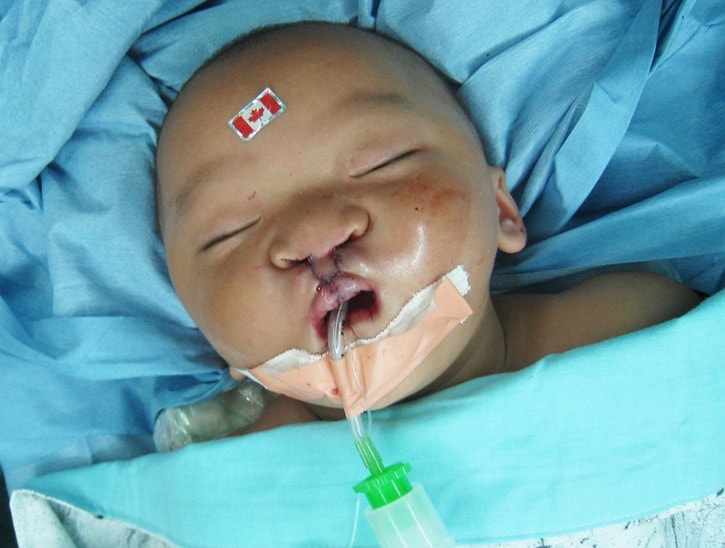Last fall, a group of 26 westerners, exhausted by a cross-Pacific flight and a five-hour bus ride through the hazy agricultural patchwork of north-central China, were greeted by hundreds of well-wishers in the “small city” of Linyi, home to 10 million people.
Following an indoor ceremony of banners, colours and speeches, the visitors got down to business – work that would involve 102 operations over 10 days for 76 young patients who needed facial reconstructive surgery.
A cleft lip or palate isn’t a life-threatening condition. In B.C., babies born with the split in the lip or an opening in the roof of the mouth – about 200 a year – are operated on quickly and safely. It’s not a major medical concern.
But in developing countries, with few affordable options to repair the birth defects, children can grow up with dental or speech problems, difficulty eating, social stigmas and possible rejection by their community.
That’s where Operation Rainbow Canada (ORC) comes in.
The group of doctors, nurses and support staff volunteer to provide free reconstructive plastic surgery for cleft lip and palate deformities to children in need.
Led by plastic and reconstructive surgeon Dr. Kimit Rai since the non-profit society’s formation in 1998, ORC has performed surgeries on more than 1,800 children in 28 missions in countries such as Cambodia, India, Mexico, the Philippines and Lebanon.
Each mission involves the coordination of surgeons, pediatricians, anesthesiologists, nurses (pre-op, OR and recovery) and support staff, along with the shipping surgical equipment, lights, anesthesia machines and drugs, antibiotics and other supplies.
Most recently, the mission coordinator was Surrey nurse Rema Nair.
Last year’s China mission came with its own set of unique challenges.
Hundreds of patients showed up at the hospital, which kept society chairperson John Buis busy taking photos of the babies and children to keep track of the faces during in-take and post-op.

Translation, name and pronunciation difficulties made it necessary to use numbers.
Baby #22, for instance, had a bilateral cleft lip as well as a cleft palate that will require more surgery in the future.
Quick to smile before the surgery, the youngster woke up from the two-hour surgery looking confused but with only a couple of small scars on his upper lip.
Some patients required more than one surgery over the course of the 10 days.
The mission was so successful, says Rai, that the Chinese hospital asked ORC to return to teach local doctors and nurses how to do their own surgeries.
Buis, a handlebar-moustacheoed 34-year member of the RCMP – who coincidentally was promoted to Staff-Sergeant/Major while airborne on the way to China – became involved with ORC through his own need for reconstructive surgery.
Buis was shot in both thighs while on duty in Burnaby in 1979 and required seven surgeries over the next decade – all performed by Rai, who worked at Royal Columbian Hospital.
The two got to know each other well over the years.
Buis’ experience with two United Nations missions in Bosnia and East Timor would help ORC deal with bureaucracy and logistics in two of its latest missions.
Rai, a Malaysian Army surgeon in the 1960s, turned to reconstructive surgery after meeting a Canadian doctor and getting a fellowship in the specialty in a Canadian hospital.
In the early ‘90s, Rai travelled with a fellow surgeon on an American mission to the Philippines.
“We did some surgeries on cleft lip and palate patients and I felt really charged up,” he says in his Vancouver office. “I felt really good at fixing children.”
A year later, he convinced four Canadian nurses to come with the same American group.
Over time, he realized he could push the Canadian medical community to better represent itself.
Several years and many discussions later, ORC was founded – supported by fundraising and volunteers.
So far, two 10-day missions have taken place each year, but that may soon be reduced to just one due to a combination of the stressful nature of the missions and a lack of money.
Each trip costs about $28,000 in supplies alone, and up to $70,000 including plane tickets, food and accommodations (if the latter two are not provided by the host country, which is sometimes the case).
Often, ORC supplies are left in the hospital for locals to use once the team departs.
In one case, surgical drapes were left as sheets on the bare-wire post-op beds in a primitive Cambodian hospital.
Just one mission, in Indonesia in 2009, would be described as unsuccessful.
“Everything was organized and we were ready to operate, but somehow the local anesthesiologists couldn’t get along,” explains Rai. “There was friction between our doctors and their doctors.”
After not being able to get permission to be responsible for the patients, the ORC group took the next flight out.
“Out of 28 missions, I don’t think one failure is too bad,” says Rai.
In general, the Canadian volunteers have been welcomed with open arms – followed by post-surgery smiles.
“When we go to the countries, we teach (medical staff) pediatrics, we teach them nursing, we teach them how to operate, we teach them post-operative recovery. We also take our own residents who are training in plastic surgery from Canada to learn, so there’s an education component to that.”
Gratitude for ORC volunteers has been shown in many different ways: A lot of toasting took place in China. In Mexico, they received wrapped gifts. In India, they were hugged often. In the Philippines, they got baskets of fruits and vegetables. And in Lebanon came pistachios.
“They’re very pleased to see you because you’re treating their children,” says Rai.
“They were tickled pink to have us there,” volunteer videographer Gary Hanney said of the China mission.
In March, Operation Rainbow returns for a second time to the Himalayas.
For more information or learn how you can sponsor a smile, visit http://operationrainbowcanada.com
bjoseph@surreyleader.com
